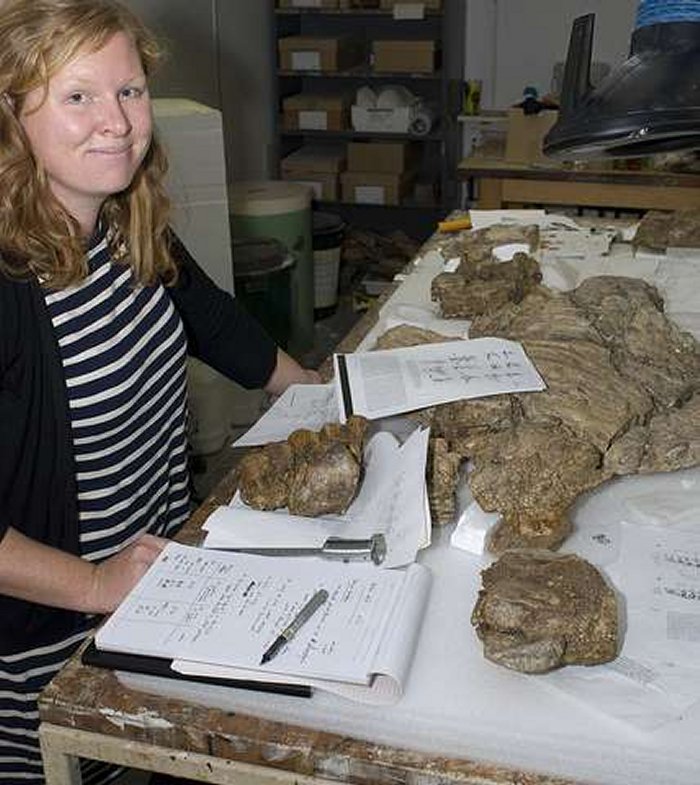Kunbarrasaurus: New Armoured Dinosaur Revealed
MessageToEagle.com – Meet the Kunbarrasaurus – a new armoured dinosaur that once roamed the Earth. It has a parrot-like beak, bones in its skin and an inner ear that is proportionately enormous and unlike anything scientists have seen before in a dinosaur. It looks more like the inner ear of a Tuatara or a turtle.
The skeleton of Kunbarrasaurus (koon-ba-rah-sore-rus) was discovered in 1989, but new research from a team led by University of Queensland experts has revealed the dinosaur is a distinctly different species than previously thought.
The dinosaur lived in Australia and it was a unique type of animal.
UQ School of Biological Sciences PhD student Lucy Leahey said the fossil represented the most complete dinosaur so far discovered in Australia and one of the best-preserved ankylosaur fossils in the world.
“Ankylosaurs were a group of four-legged, herbivorous dinosaurs, closely related to stegosaurs,” Ms Leahey said.
“Like crocodiles, they had bones in their skin and are commonly referred to as ‘armoured’ dinosaurs.”

“When it was first studied back in the 1990s, the fossil was placed it in the same genus as Australia’s only other named ankylosaur, Minmi, which is based on some bones from Roma in south-western Queensland.”
The team’s research found the fossil was different to the Roma Minmi, and distinct enough from all other ankylosaurs to warrant a new name.
“Kunbarra is the word for ‘shield’ in the Mayi language of the Wunumara people from the Richmond area, and the species name honours the person who originally found the fossil, Mr Ian Ievers. It means ‘Ievers’ shield lizard,” Ms Leahey said.
Research that started in 2007 involved careful preparation of the palate of the dinosaur at the Denver Museum of Nature and Science, along with CT scanning at the Mater Adult Hospital.
Professor Lawrence Witmer from the Ohio University Heritage College of Osteopathic Medicine used the information to create a 3D reconstruction of the brain, inner ear and nasal cavities, which can be viewed here.

“The CT reconstruction revealed that Kunbarrasaurus had a more complicated airway than other dinosaurs, but less so than ankylosaurs from the Northern Hemisphere,” Professor Witmer said.
Scientists say the Kunbarrasaurus specimen should be considered as a new dinosaur.
See also:
Rare Giant 170-Million-Year-Old Dinosaur Footprints Found On Isle Of Skye
Rare Fossil Of Dog-Sized Horned Dinosaur From “Lost Continent” Identified By Scientists
“Our work has also revealed that Kunbarrasaurus is more primitive than the majority of other well-known ankylosaurs from North America and Asia.”
“It appears to represent an early, less heavily ‘armoured’ member of the group, close to the point at which the ankylosaurs diverged from the other main lineage of armoured dinosaurs, the stegosaurs.”
The skeleton of Kunbarrasaurus ieversi is on display at the Queensland Museum (Southbank).
The research is available online in the open access journal PeerJ.
MessageToEagle.com
Source:
Related Posts
-
 Amazing Memory – People Who Remember Every Day Of Their Life
No Comments | Dec 17, 2015
Amazing Memory – People Who Remember Every Day Of Their Life
No Comments | Dec 17, 2015 -
 Your Pet Does Have A Facial Expression And You Can Learn How To Read It
No Comments | Dec 3, 2019
Your Pet Does Have A Facial Expression And You Can Learn How To Read It
No Comments | Dec 3, 2019 -
 Sarmizegetusa And Its Andesite Sun Artifact Similar To The Mayan Calendar
No Comments | Apr 13, 2021
Sarmizegetusa And Its Andesite Sun Artifact Similar To The Mayan Calendar
No Comments | Apr 13, 2021 -
 Enigmatic ‘Stone Sleepers’ – Megalithic Tombstones ‘Stecci’ In The Western Balkans
No Comments | Mar 31, 2016
Enigmatic ‘Stone Sleepers’ – Megalithic Tombstones ‘Stecci’ In The Western Balkans
No Comments | Mar 31, 2016 -
 Why Popcorn Is An Ancient Superfood That Gives You A Kick
No Comments | Nov 23, 2015
Why Popcorn Is An Ancient Superfood That Gives You A Kick
No Comments | Nov 23, 2015 -
 Our Brain Is A Holographic Machine Existing In A Holographic Universe
No Comments | Apr 9, 2014
Our Brain Is A Holographic Machine Existing In A Holographic Universe
No Comments | Apr 9, 2014 -
 Unique Photos From Inside Of Ancient Tombs In Egypt’s Valley Of The Kings Revealed
No Comments | Oct 8, 2016
Unique Photos From Inside Of Ancient Tombs In Egypt’s Valley Of The Kings Revealed
No Comments | Oct 8, 2016 -
 Pothos Ivy – This Plant Can Clean Your Home’s Air
No Comments | Jan 17, 2019
Pothos Ivy – This Plant Can Clean Your Home’s Air
No Comments | Jan 17, 2019 -
 Mysterious Ruins Of Nuevo Albergis In The Atacama Desert
No Comments | Feb 27, 2014
Mysterious Ruins Of Nuevo Albergis In The Atacama Desert
No Comments | Feb 27, 2014 -
 A 2,500-Year-Old Planned City In Tarighat, Chhattisgarh, India
No Comments | Oct 8, 2014
A 2,500-Year-Old Planned City In Tarighat, Chhattisgarh, India
No Comments | Oct 8, 2014
